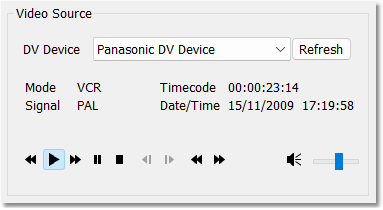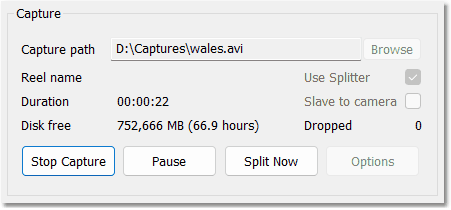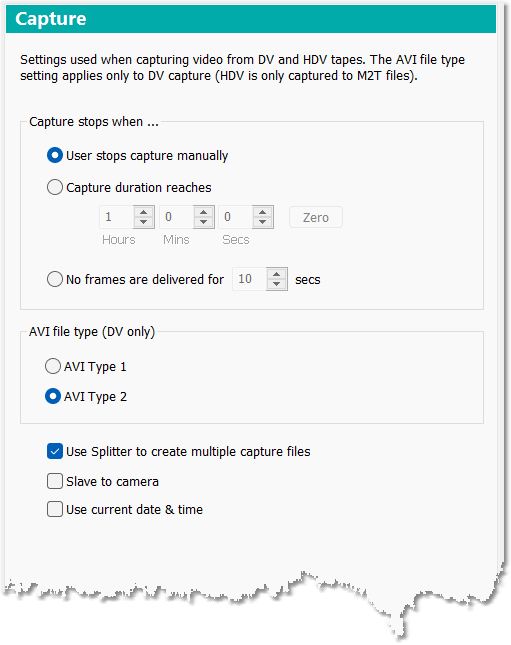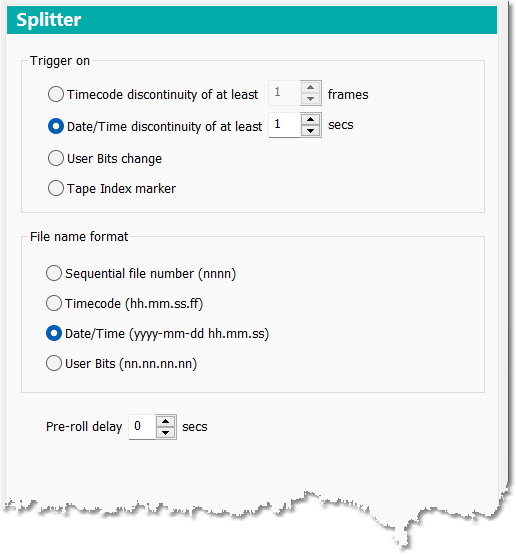 The Capture DV / HDV window is activated from the File > Capture DV / HDV menu.
The Capture DV / HDV window is activated from the File > Capture DV / HDV menu.
It allows you to capture standard definition DV video via a firewire cable from your NTSC or PAL DV camera (or an HDV camera which is set to operate in DV mode) to one or more AVI files on your computer's hard drive.
You can also capture high definition HDV video from your HDV camera via firewire to one or more M2T files.
DVMP Pro also supports capture of DV video via "UVC". A tiny number of Panasonic DV cameras support the capture of full resolution DV video via a USB cable by using a technology called "UVC". Most DV cameras that have USB sockets do not have UVC capabilities and can only transfer poor quality, low resolution video via USB. But if you have one of the UVC-capable Panasonic models then you can use DVMP Pro to capture full resolution DV video via USB, without having to resort to a firewire connection which is becoming increasingly difficult to do with modern computers that do not come equipped with firewire sockets.
Although HDV cameras record to the same physical tape cassette as DV cameras, the recording format is very different to DV, and in all other respects they are completely different.
|
INFORMATION: Capture DV / HDV is only for use with tape-based DV and HDV cameras. "Capturing" does not apply to other camera types that record directly onto memory cards or hard drives because the camera already stores its recordings in video files on its own media - these video files can then be simply copied (not captured) to the computer. |
You can set your DV or HDV camera to VCR mode and capture from tape.
You can also perform "live" capture from the camera by setting it to Camera mode, even with no tape loaded in the camera.
You can also set the Slave to Camera option which starts and stops capture when you use the camera's pause button.
The capture can be made to a single file or split between multiple files (AVI files for DV, and M2T files for HDV). You can set rules for when the splitting occurs, such as when sudden changes in the date and time of recording occur.
Capture will continue unhindered across timecode breaks and unrecorded areas of tape (unless you set splitter rules).
The Capture DV / HDV window is comprised of 4 main parts which are summarised below. For greater detail, see the section How to use the Capture DV / HDV window further down the page.
Video Preview Pane
The preview pane displays the video from the camera, whether or not a capture is in progress. The first time the Capture DV / HDV window appears, the video pane area will be quite small, but you can increase its size by dragging the window border vertically. The new size and position on screen will be remembered and used each time you open the Capture DV / HDV window in future.
Video Source section
 The Video Source section is to the left of the window. This displays the name of the DV or HDV capture device that is being used, and some tape transport buttons which you may find more convenient to use than the controls on your camera. You can see a tool-tip description of each key when you hover the cursor over it.
The Video Source section is to the left of the window. This displays the name of the DV or HDV capture device that is being used, and some tape transport buttons which you may find more convenient to use than the controls on your camera. You can see a tool-tip description of each key when you hover the cursor over it.
Some of these buttons also have a hot key associated with them.
Note that the Play Rewind and Play Fast-Fwd buttons adjacent to the Play button have the same effect as pressing the camera's rewind and fast-forward buttons while the tape is playing - you can continue to view the video in the Video Pane. The Rewind and Fast Fwd buttons further to the right have the same effect as pressing the camera's rewind and fast-forward keys from a stopped position - winding is faster and there is no preview available because the tape is not threaded around the heads.
The table below lists the keys as they appear in the Capture DV / HDV window from left to right.
Button |
Hot Key |
Operation |
|---|---|---|
|
Play Rewind |
|
|
SPACE |
Play |
|
Play Fast Forward |
|
|
SPACE |
Pause |
|
. or S |
Stop |
|
Cursor LEFT |
Back Frame |
|
Cursor RIGHT |
Forward Frame |
|
R |
Rewind |
|
F |
Fast Forward |
To the right of the tape transport buttons is a mute button and volume control which adjusts the loudness of the audio heard from your speakers - it does not affect the captured sound level.
The camera's state is also displayed - e.g. Mode ("VCR" or "Camera"), Timecode and Date/Time.
Capture section
 The Capture section is on the right of the window. This holds the controls for starting and stopping capture to the hard drive, the area on your hard drive where the capture files will be stored, the capture options, and various other information.
The Capture section is on the right of the window. This holds the controls for starting and stopping capture to the hard drive, the area on your hard drive where the capture files will be stored, the capture options, and various other information.
The Capture Path and its Browse button is where you set the folder where all of the capture files will be created, the "stem" file name that all of the capture files will begin with, and a Reel name.
The Capture button starts and stops capture. The Pause button pauses and resumes capture. The Split Now button allows you to force an immediate split - the current capture file will be closed and a new one started. The Options button pops up a window containing the Capture options (these are the same as you will see in the main Tools > Options menu). For convenience, the current setting of two of the options are also displayed on the right of the Capture section: Use Splitter and Slave To Camera - you can also change the settings here as a quicker alternative to clicking the Options button.
Other information displayed is the current Reel name (if any), the amount of free disk space on the partition where the Capture Path is located, the current capture duration, and the number of dropped frames.
File Info section
 The section at the bottom of the window shows the File Path of the current (or last) capture file, and the File Number which is a count of how many times a split has occurred during capture. The pathname of the capture Log file is also shown and the text of the Last Error that occurred (if any).
The section at the bottom of the window shows the File Path of the current (or last) capture file, and the File Number which is a count of how many times a split has occurred during capture. The pathname of the capture Log file is also shown and the text of the Last Error that occurred (if any).
The status of the capture's internal Buffer is also shown.
The Close button closes the Capture DV / HDV window.
How to use the Capture DV / HDV window
You open the Capture DV / HDV window by clicking the File > Capture DV / HDV menu on the main DVMP Pro window.
When the Capture DV / HDV window appears it will scan for any active firewire (or UVC) DV or HDV capture devices that are connected to your PC, and add their names to the Device dropdown box. If no such devices are found then the Device box will remain empty.
A device is only "active" if the DV/HDV camera is plugged into the firewire port (or the USB port for UVC-capable models), and also switched on in either VCR or Camera mode; otherwise the device will not be found and it will not be added to the Device box. Note that for HDV cameras that are set to operate in DV mode, they effectively become a standard DV device.
You can plug in and power-on your DV/HDV camera at any time and within a few seconds the device will be detected and automatically added to the Device box (except while a capture is in progress). If you unplug or power-off your camera at any time it will automatically be removed from the Device box, and if a capture was in progress it will be ended cleanly.
When you plug in and power-on your camera and it is added to the Device list, the video preview pane will display the video frames that are being sent from the camera, whether the camera is in VCR mode or Camera mode. In Camera mode the video display will be a live view of what the camera sees. In VCR mode it will show the playback from the tape, but if no tape is playing the video pane will remain unchanged.
The first time the Capture DV / HDV window appears, the video pane area will be quite small, but you can increase its size by dragging the window border vertically. The new size and position on screen will be remembered and used each time you open the Capture DV / HDV window in future.
If your camera is in VCR mode, you can use any of the on-screen tape transport buttons to play, pause, fast forward/reverse etc - you may find this more convenient than operating the camera's own tape transport buttons. If it is in Camera mode, the transport buttons are greyed-out.
Before you can start capturing, you must tell Capture DV / HDV where you want the capture files to be stored on your hard drive, and also the file name you would like the files to begin with. You do this by clicking the Capture Path's Browse button which pops up a Set Capture File Name box. Here you specify the folder location, the File name and optionally a Reel name.
Obviously all of the capture files can not be given the same file name, so each file will automatically be given a unique suffix - more of which later.
The Disk Free Space indicator will then update to show the estimated amount of hard drive space available on the partition where your Capture Path is located.
Now click the Options button and the Capture Options window will appear. This shows the options that are relevant for Capture DV / HDV (these are the same options that you will see in the Capture section of the Tools > Options menu).
 The Capture options allow you to set when you want capture to stop. By default, capture will only stop when User stops capture manually by clicking the Stop Capture button. But instead you can specify Capture duration reaches in hours, minutes and seconds - when this duration is reached the capture will automatically stop, and the tape transport will stop too.
The Capture options allow you to set when you want capture to stop. By default, capture will only stop when User stops capture manually by clicking the Stop Capture button. But instead you can specify Capture duration reaches in hours, minutes and seconds - when this duration is reached the capture will automatically stop, and the tape transport will stop too.
You can also specify No frames are delivered for N seconds - this requires some explanation. When capturing from a tape, frames are delivered from the camera continuously until an unrecorded area of tape is encountered. No frames are delivered during an unrecorded section, and so this could indicate the end of the recording on the tape. But if the tape had been previously used or had been striped then even apparently "blank" areas of tape will have been recorded onto, and so the camera will still deliver frames. This is therefore not a reliable indicator of the end of a recorded area of the tape, except perhaps where the tape had been used for the first time. However if you find this feature useful, you can set a number of seconds and if no frames are delivered for that length of time then capture will stop automatically, otherwise capture will continue unhindered across unrecorded areas of tape.
You can also set the required AVI file type of the DV capture files to AVI Type 1 or AVI Type 2. HDV capture files are always M2T type.
If you tick Use current date & time the capture files will have their recording date and time embedded metadata overwritten with the current date and time. This means that the captured files will have the date and time of their capture instead of when they were originally recorded on tape.
Capturing can either be done to a single file, or can be automatically split to multiple files. The option Use Splitter to create multiple capture files allows you to specify whether you want a single capture file, or to use the Splitter to create multiple files. The Splitter is actually the same tool that can be found in the Tools > Split DV AVI or HDV M2T File menu, but here it is used "on the fly" to split the DV or HDV data coming from the camera into multiple capture files. Please note that a split will always occur if the audio properties (e.g. sampling frequency) change.

If you tick Use Splitter to create multiple capture files then you can click the Splitter page selector (on the left of the Capture Options window) and set the options for the Splitter which will dictate how and where the splits will occur. You can also set the File name format which specifies the file name suffix that each capture file will be given when it is created. Depending on which option you choose, each capture file will be suffixed with a sequential file number, the start timecode or recording date/time of the file, or the user bits value.
Here are some example file names:
myfile 0001.avi
myfile 00.01.45.52.avi
myfile 2009-01-16 13.36.45.avi
myfile 00.11.0A.01.avi
You can also set a preroll delay. See the Options - Splitter page for more details of the Splitter options.
When you have set the required Capture and Splitter options, click OK to return to the Capture DV / HDV window.
You will notice that the Use Splitter and Slave to Camera options are also shown on the right of the Capture DV / HDV window. This allows you to see the current setting of these options without having to go into the Options window, and also allows you to change their settings more quickly.
You can now start capturing by clicking the Capture button. If the camera is in VCR mode, it will start to play automatically and the capture will start. If it is in Camera mode then live capture will begin.
Capture will continue until you stop it manually by clicking the Stop Capture button, or until your selected Capture stops when condition is triggered. You will also cause a capture to stop in VCR mode if you click one of the tape transport buttons which would take the camera out of play mode. Capture also stops cleanly if the disk becomes full or the camera is powered-off or unplugged.
When capture stops, you can check the contents of the capture log file if you wish. The pathname of the Log File is displayed near the bottom of the Capture DV / HDV window. A new capture log file is started each time you start a new capture session by pressing the Capture button.
During capture you can click the Pause button. This temporarily stops the storage of frames in the capture file, but it does not stop the capture itself. If the camera is in VCR mode then the tape will continue to play. In effect the frames coming from the camera are being discarded. You can continue capturing by clicking the Resume button which resumes the storage of the frames in the capture file - note that this may trigger a new capture file to be created depending on your Splitter settings.
You can also click the Split Now button which will manually force a split to occur. The current capture file is immediately closed and a new one is created. Please note that for HDV capture, the split occurs at the next I-frame (these usually occur twice per second).
Each time a split occurs, the File Number increments and the new capture File Path is shown.
Each capture file has its Date modified file property set to the start date and time that it was recorded. The Date modified file property is displayed in File Explorer and in the file properties window of many video editing applications, so it provides an easy way of seeing when the footage in each file was actually recorded (rather than when the file was created on the hard drive).
Capture DV / HDV has a large internal memory buffer which it uses to store frames temporarily if they can not be written to the hard drive quickly enough. This may happen if your PC is fairly slow or is doing other activities at the same time as the capture is taking place. This buffer helps to avoid dropped frames. The Buffer indicator shows how much of the buffer is being used - if the indicator gets close to the end of the scale then there is a danger of dropped frames. However most modern PCs have more than enough power to capture DV data with ease (HDV slightly less so), so you may rarely see the level get above zero unless you are running other intensive programs at the same time.
Live capture
If you switch the camera to Camera mode, then you can capture from it without actually recording to tape - in fact you can have no tape in the camera at all. This is called "live" capture. Even though the camera is not recording to tape (or may have no tape inserted) it still sends DV frames to the PC.
You can use this "live" capture feature to effectively use your PC's hard drive as a huge DV recorder, without also having to use any DV tapes in your camera.
You can also use the Slave to Camera option. In this case, when you press the pause button on your camera to start or stop recording, capture to the hard drive will simultaneously be started and stopped automatically without you having to click any PC on-screen buttons. In effect, capture to the hard drive is being controlled from the camera's own pause button. However this feature only works if you have a tape in your camera because the camera's firmware disables the pause button when no tape is present. Also, if you are capturing from a UVC-capable DV camera via the USB cable you will probably find that Slave to Camera will not work, because while the camera is recording it will not send video frames to the computer.
Note that with some cameras the timecode may be offset by a few frames between the same live-captured and tape-captured footage. This is a hardware anomaly of particular cameras and is not specific to DVMP Pro. You should be aware of this if you are likely to use both live-captured and tape-captured footage in the same project.
See Also:







